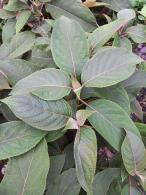Get Additional 5% Off 1st Order
Hydrangea Aspera Anthony Bullivant
Large Handsome Hydrangea Variety
1. Add items to basket
2. Go to the basket
3. Enter your postcode in Delivery Price Check
Plant shape: Bush
Pot size: 20 Litres
Plant ID: 14767 2
click to view this plant size >
Hydrangea aspera Anthony Bullivant is an RHS AGM-winning deciduous hydrangea with large flat heads of pink, purple and blue flowers. It suits a large mixed border and cottage-style gardens.
Hydrangea Aspera is native to the Himalayas, southern China and Taiwan where it prefers a sheltered position due to its large leaves. The Anthony Bullivant variety originated at Stourton House, Wiltshire and was named by Elizabeth Bullivant after her husband. This variety is synonymous with Hydrangea Villosa Anthony Bullivant.
This large hydrangea has softly hairy leaves hence the name aspera which is Latin for ‘rough-texture’. Its foliage is bushy with each leaf up to 25 cms long. Its foliage appears in early spring and is followed by extraordinary flowers in late summer. Large flat heads of tiny dark blue and purple florets surrounded by larger pale pink flowers emerge in July. Because the colour tones are variable, no two shrubs are the same.
Height and Spread of Hydrangea Aspera Anthony Bullivant
This large hydrangea can reach four metres in height and 2.5 metres in spread over 5-10 years
How Hardy Is Hydrangea Aspera Anthony Bullivant
Hydrangea Anthony Bullivant is hardy in the UK if its roots are well drained.
How To Use Hydrangea Aspera Anthony Bullivant
Perfect for an informal mixed border and country cottage gardens Hydrangea Anthony Bullivant brings a hit of impressive late summer colour. In small urban gardens, it’s a centrepiece with its variable multi-toned flowerheads that grab all the attention. Wildlife-friendly low-maintenance gardens benefit from its tough nature and easy-to-grow aspects. It thrives in a sheltered wall side border with other pollinator-friendly shrubs.
How To Care for Hydrangea Aspera Anthony Bullivant
Plant it in a sunny to partially sunny position with shelter from cold, drying winds that can tear its large leaves. It’s not fussy about soil type and will grow in sand to clay if it’s well-watered. Pruning isn’t necessary, but you can remove broken or crossed branches after the flowers are finished.
A thick layer of organic mulch to the roots and regular watering in dry spells will keep its flowers coming until the temperature drops in autumn.













